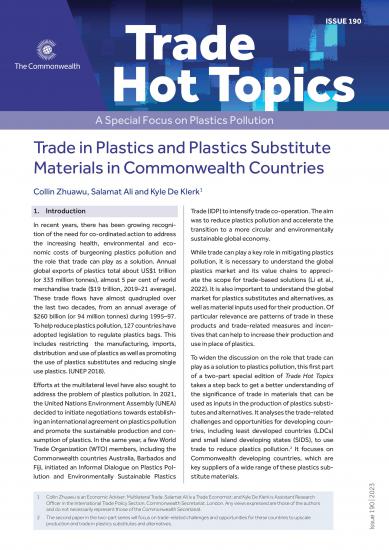Trade in Plastics and Plastics Substitute Materials in Commonwealth Countries
Synopsis
In recent years, there has been growing recognition of the need for co-ordinated action to address the increasing health, environmental and economic costs of burgeoning plastics pollution and the role that trade can play as a solution. Annual
global exports of plastics total about US$1 trillion (or 333 million tonnes), almost 5 per cent of world merchandise trade ($19 trillion, 2019–21 average). These trade flows have almost quadrupled over the last two decades, from an annual average of
$260 billion (or 94 million tonnes) during 1995–97. To help reduce plastics pollution, 127 countries have adopted legislation to regulate plastics bags. This includes restricting the manufacturing, imports, distribution and use of plastics as well as promoting
the use of plastics substitutes and reducing single use plastics. (UNEP 2018).
To widen the discussion on the role that trade can play as a solution to plastics pollution, this first part of a two-part special edition of Trade Hot Topics takes a step back to get a better understanding of the significance of trade in materials that can be
used as inputs in the production of plastics substitutes and alternatives. It analyses the trade-related challenges and opportunities for developing countries, including least developed countries (LDCs) and small island developing states (SIDS), to use trade to reduce plastics pollution.2 It focuses on Commonwealth developing countries, which are key suppliers of a wide range of these plastics substitute materials.

Downloads
Forthcoming
Online ISSN
Categories
License

This work is licensed under a Creative Commons Attribution-NonCommercial-NoDerivatives 4.0 International License.

